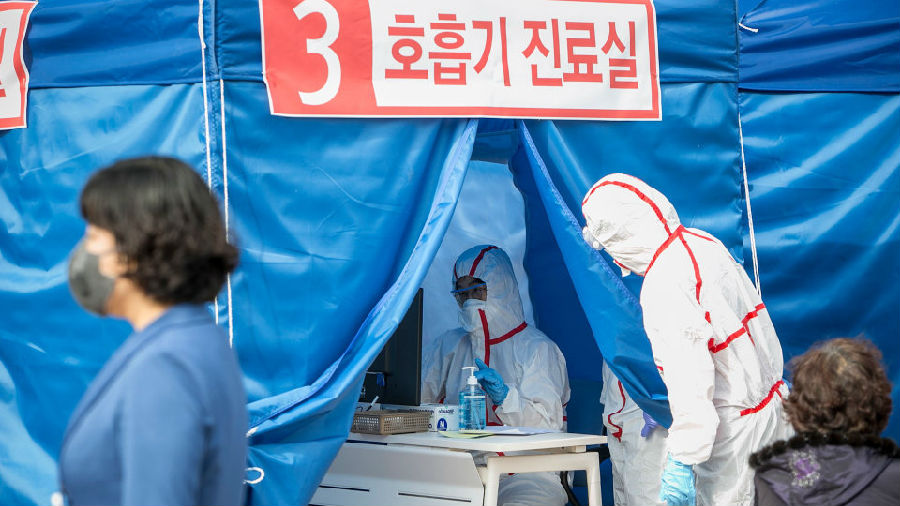After Daegu, Korea ramped up testing around the country.
检测了大邱的人群之后,韩国在全国各地都加大了测试力度。
Private and national healthcare systems joined forces to set up a mostly free testing effort
私人医院机构和国家公立医疗机构开始携手开展检测(基本免费)工作,
that includes more than 600 locations that screen as many as 20,000 people per day.
他们设立了600多个检测点,每天筛查的人数多达2万人。
Through this system, when anyone tests positive,
有了这个检测系统,只要有人检测呈阳性,
the government is able to test and trace their contacts to continue to break the transmission chains of the coronavirus on a large scale.
政府就能对他们的接触者展开追踪及检测,进一步切断冠状病毒的大型传播链。
But that’s just the human to human transmission, the infected person may have moved through the city, touching subway poles and door handles.
这还只是人与人直接传播的情况,此外,感染者还可能在城市中走动过,触摸过地铁扶手和门把手。
And South Korea had prepared for this too.
这方面,韩国也已经做好了准备。
After the MERS outbreak, when they weren’t able to trace the movements of the virus,
MERS爆发时,韩国官方还没有能力追踪病毒的扩散,
Korea changed the law, allowing the government to collect a patient’s data and security footage during an outbreak.
他们便修订了法律,允许政府在疫情期间收集患者的数据和安全影像。
All their steps are logged and then shared to alert people to stay away from the path of infection.
他们将每一步工作都记录了下来,然后分享给大家,提醒大家远离感染路径。
"If there is some confirmed case found near my office, they message my smartphone.
“如果他们在我办公室附近发现了确诊病例,他们会往我手机上发信息。
There is a confirmed case near you place.
告诉我,你附近有一例确诊病例。
He moved someplace to another place.
他曾从某地去过某地。
Be cautious."
请您注意保护自己。”
Websites and private apps compile the information,
许多网站和软件也开始汇编这些信息,
allowing everyone to see if a person with a confirmed case of coronavirus went to a pharmacy or the hospital, or anywhere else.
让所有人都能看到确诊患者是否去过药房,医院或其他任何地方,
And they’ll know how recently they went too.
具体是什么时候去的等等。
"It's a means of checking the possibility of infection."
“这是筛查感染可能性的一种手段。”
"Citizens are checking the coronavirus locations and are avoiding going to these areas."
“市民正在确认新增确诊病例所在的位置,并避免前往那些地方。”
This information lets people know if they’ve crossed paths with an infected person so they can go get tested for the virus.
这些信息能让人们知道他们是否与感染者相遇过,是否有必要去接受检测。
And contact tracing starts all over again.
接触追踪又启动了。

Tracing people's every move can be controversial, but many in South Korea prioritize public health over privacy in an outbreak.
追踪人们的一举一动或许存在一定的争议,但面对疫情,许多韩国人都将公共健康看得比隐私更为重要。
As a result, South Korea was able to test hundreds of thousands of people, more than any other country at the time.
最终,韩国对数十万民众都进行了检测,检测规模比当时的任何其他国家都大。
And this made it easier for authorities to see the virus.
这样一来,当局也能更容易看到病毒。
To see where it’s located and where it may be lurking.
看到它的位置以及它可能潜伏的位置。
This ability to find and treat infected people has allowed Korea to avoid aggressive lockdowns.
正因为有这种查找并治疗感染患者的能力,韩国才得以幸免于严格的封城举措。
And it's helped bend the curve of the outbreak that started out dangerously steep.
也正因为如此,原本增速十分危险的疫情曲线才逐渐平稳了下来。
For now, Korea has turned a corner, but they continue to be prepared.
目前,韩国已经渡过难关,但他们再次走上了未雨绸缪的道路。
"We are very cautious to prevent a second wave.
“我们正在十分谨慎地预防疫情的二次反弹。
Every day is kind of a state of war."
每天基本都是战斗状态。”
It's that kind of vigilance that has set Korea apart in the coronavirus pandemic.
正是这种警惕让韩国在新冠病毒大流行之际从众多国家中脱颖而出。
But it wasn’t the only place to test people aggressively.
然而,韩国并非唯一实行严格检测的地方。
Singapore, Taiwan, and other neighbors saw the benefits of widespread testing too.
新加坡、台湾及其他周边地区也看到了大规模检测的红利。
Now countries like Germany and the UK are starting to implement aggressive testing.
现在,德国、英国这样的国家也已经开始实行严格的检测措施。
And even the US, where the government has failed to provide adequate testing, is now scrambling to test more people.
即使是政府没能提供足够检测的美国,现在也开始迫切地检测大家了。
"We know that we have to do more and we continue to accelerate in testing."
“我们知道我们做的还不够,我们还需要进一步加快检测的步伐。”
Korea's strategy of contact tracing might not be easy to replicate in countries with much larger populations.
人口比韩国多得多的国家要复制韩国追踪接触的经验或许并不容易。
But the country’s success with widespread testing, still offers a way out for most countries that are stuck in lockdowns.
但该国大规模测试方面的成功经验依然能为大部分陷入封锁的国家提供一条出路。











